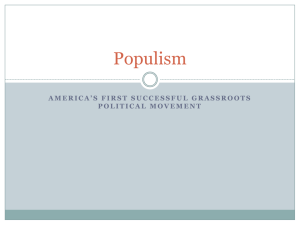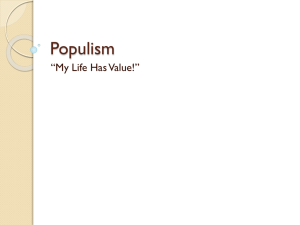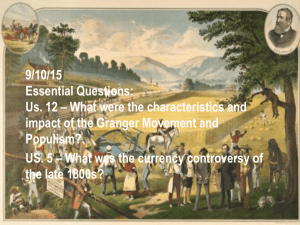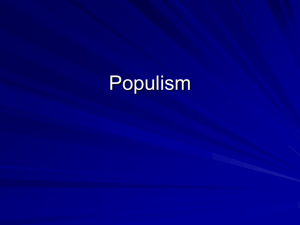"Populism" article
advertisement
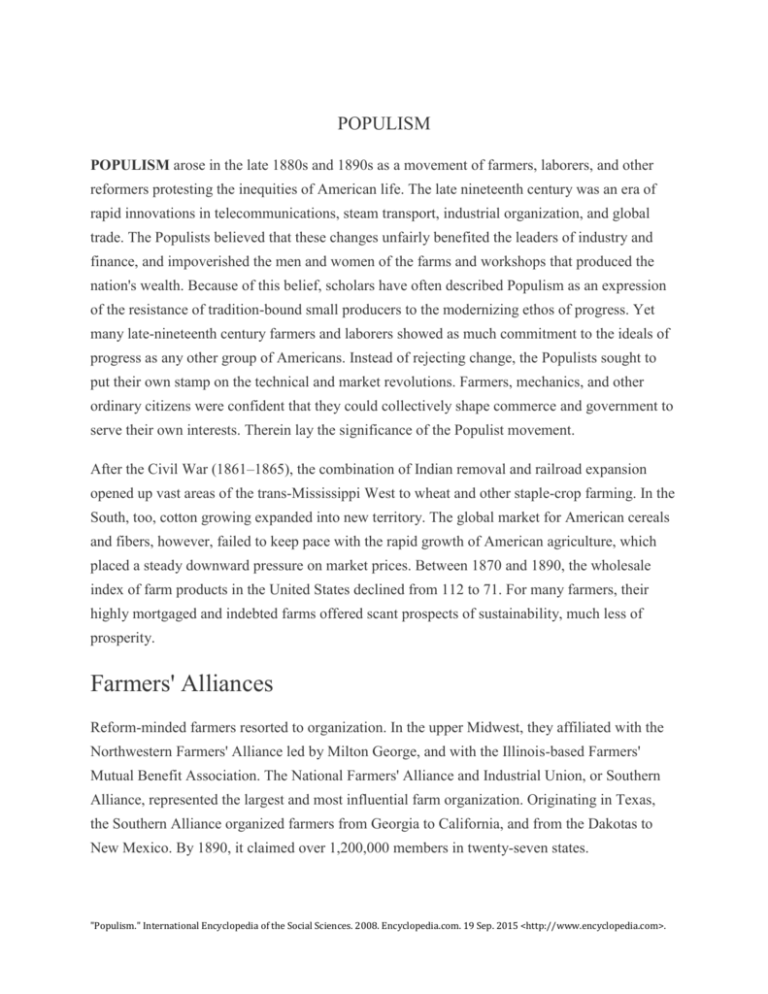
POPULISM POPULISM arose in the late 1880s and 1890s as a movement of farmers, laborers, and other reformers protesting the inequities of American life. The late nineteenth century was an era of rapid innovations in telecommunications, steam transport, industrial organization, and global trade. The Populists believed that these changes unfairly benefited the leaders of industry and finance, and impoverished the men and women of the farms and workshops that produced the nation's wealth. Because of this belief, scholars have often described Populism as an expression of the resistance of tradition-bound small producers to the modernizing ethos of progress. Yet many late-nineteenth century farmers and laborers showed as much commitment to the ideals of progress as any other group of Americans. Instead of rejecting change, the Populists sought to put their own stamp on the technical and market revolutions. Farmers, mechanics, and other ordinary citizens were confident that they could collectively shape commerce and government to serve their own interests. Therein lay the significance of the Populist movement. After the Civil War (1861–1865), the combination of Indian removal and railroad expansion opened up vast areas of the trans-Mississippi West to wheat and other staple-crop farming. In the South, too, cotton growing expanded into new territory. The global market for American cereals and fibers, however, failed to keep pace with the rapid growth of American agriculture, which placed a steady downward pressure on market prices. Between 1870 and 1890, the wholesale index of farm products in the United States declined from 112 to 71. For many farmers, their highly mortgaged and indebted farms offered scant prospects of sustainability, much less of prosperity. Farmers' Alliances Reform-minded farmers resorted to organization. In the upper Midwest, they affiliated with the Northwestern Farmers' Alliance led by Milton George, and with the Illinois-based Farmers' Mutual Benefit Association. The National Farmers' Alliance and Industrial Union, or Southern Alliance, represented the largest and most influential farm organization. Originating in Texas, the Southern Alliance organized farmers from Georgia to California, and from the Dakotas to New Mexico. By 1890, it claimed over 1,200,000 members in twenty-seven states. "Populism." International Encyclopedia of the Social Sciences. 2008. Encyclopedia.com. 19 Sep. 2015 <http://www.encyclopedia.com>. Charles Macune, the president of the Southern Alliance, believed that farmers had to organize as a business interest on a par with other commercial interests. Accordingly, farmers' organizations lobbied to raise the position of agriculture in the national economy. They sought diffusion of commercial, scientific, and technical knowledge. They advocated cooperative business principles and experimented with large-scale incorporated enterprises to regulate cotton and other agricultural markets. They also pressed for an expanded government role in the farm economy. They took the federal postal system as a model of potential reform, and demanded postal savings banks, a postal telegraph, and nationalized railways. Macune also proposed a subtreasury system that would provide low-interest federal loans on staple crops to be stored in federal warehouses. Farm reformers also sought rural education. They campaigned for public schools and colleges. At the same time, the Alliance movement itself was to serve as "the most powerful and complete educator of modern times." The Alliances created an extensive system of literature networks, lecture circuits, and adult education across much of rural America. Farmwomen took part in this educational work in numbers then unmatched by any secular mobilization of women in American history. Roughly one out of four Alliance members was female. Their ranks included the famous orator Mary Lease, the editor Annie Diggs of Kansas, Marion Todd of Illinois, and Bettie Gay of Texas. Women often joined the rural reform movement in pursuit of female suffrage and temperance. They also sought to ease the burdens of rural labor and realize a more independent, modern life. The Alliance movement organized along strict racial lines. Many rural reformers advocated Chinese exclusion, and the Southern Alliance enforced a "whites only" rule. Although blacks joined their own Colored Farmers' Alliance, the white and black Alliances were very separate and unequal. In part, this reflected the gap between white Alliance members, who tended to be middling farmers with property, and black Alliance members, who tended to be poor renters working white owners' land as tenants or sharecroppers. It also reflected the commitment of the white Alliance to segregation and white supremacy. The People's Party The Alliance movement originally embraced a policy of nonpartisanship, which meant effecting reform by supporting sympathetic candidates within both the Democratic and the Republican Parties. Many reformers, however, grew discontent with this policy, convinced that the existing "Populism." International Encyclopedia of the Social Sciences. 2008. Encyclopedia.com. 19 Sep. 2015 <http://www.encyclopedia.com>. parties were too bound by graft and corruption to challenge corporate privilege. Such discontent provided the impulse for a third party. After a series of preliminary meetings, farm, labor, and other reform groups held the founding convention of the People's Party of the U.S.A., also known as the Populist Party. in Omaha, Nebraska, in July 1892. The Populist platform contained the fundamental Alliance demands regarding money, transportation, and land. This included the subtreasury plan, an expanded national currency and the coinage of silver to stimulate the economy and provide debt relief, a graduated income tax, government ownership of the telegraph, telephones, and railroads, and the prohibition of speculative land ownership by railroad corporations and foreign investors. The People's Party also favored the adoption of the secret ballot, direct election of Senators, legislation by referendum, and other measures to break the corrupting influence of corporate lobbyists over the political process. Populist efforts to win the support of the labor movement produced mixed results. Most urban wage earners, especially in the Northeast, where Populism had only minimal organization, showed little interest in the third party. The Populists, who were mainly native-born and Protestant, never succeeded in appealing to large numbers of Catholic and immigrant workers. Nonetheless, especially with the onset of a severe economic depression in 1893, significant sections of the labor movement looked to Populism for answers. In Chicago and other cities, socialists and trade unionists made political agreements with the People's Party. More importantly, miners and railroad workers—two of the largest and most dynamic forces in the labor movement—shared much in common with the rural Populists. They, too, sought systematic organization as a counterbalance to corporate power. They, too, believed in government intervention in the form of regulation and mandatory arbitration, and they believed in public ownership as the ultimate means to restrain the corporations. Mine workers provided the main support for the People's Party in several Midwestern and Rocky Mountain states. Many railroad employees also joined the third-party effort. The Populists supported the railroad workers in the great Pullman strike during the summer of 1894. After the suppression of the strike by federal authorities, the imprisoned leader of the railroad workers, Eugene V. Debs, emerged as one of the most highly regarded champions of the People's Party. Jobless workers also looked to the Populists. Jacob Coxey, a People's Party candidate from Ohio, led the "Industrial Armies" on a march to Washington to demand a federal "Good Roads" bill to provide jobs for the unemployed. "Populism." International Encyclopedia of the Social Sciences. 2008. Encyclopedia.com. 19 Sep. 2015 <http://www.encyclopedia.com>. Populism also provided a meeting ground for the nation's nonconformists, iconoclasts, and free thinkers. It attracted advocates of every type of social and mental innovation. Of these, the most influential were the adherents of the economic panacea movements, such as the Single Tax leagues inspired by the tax doctrines of Henry George, and the Nationalist clubs that pursued the state-capitalist utopia sketched in Edward Bellamy's novel Looking Backward (1888).The People's Party also embraced religious nonconformists. Populists were often raised in Protestant homes and held strong religious beliefs. Yet many reformers abandoned ideas of traditional piety in favor of a social gospel more fitting to the demands of secular reform. Other Populists embraced agnosticism, spiritualism, mental science, and other belief systems that they considered to be more suitable to a scientific age. Fusion and Decline The People's Party stirred deep anxiety among upper-and middle-class Americans. The political establishment attacked the Populists as "cranks and heretics" who threatened to subvert the republic with "anarchy and lawlessness." Nevertheless, Populism scored a number of electoral victories. William A. Peffer of the Kansas People's Party gained a seat in the U.S. Senate in 1890. In the 1892 presidential election, the Populist candidate James B. Weaver of Iowa carried six states with twenty-two electoral votes. That same November, the Populists elected two governors, Davis Waite of Colorado and Lorenzo D. Lewelling of Kansas. Populists in the U.S. Congress included Thomas E. Watson of Georgia, Marion Cannon of California, and "Sockless Jerry" Simpson of Kansas. These modest achievements, however, only underscored the formidable institutional obstacles facing a third party that attempted to crack the winner-take-all, two-party system. Populism struggled to present itself as a viable political alternative. By 1896, many supporters of the People's Party favored electoral combination, or fusion, with one of the dominant parties. Fusion led to the election that fall of seven senators and thirty-two congressmen supported by the Populists. Fusion also led to Populist endorsement of the 1896 Democratic presidential candidate, Nebraska Congressman William Jennings Bryan. The Democratic-Populist Bryan campaign focused on the single issue of coining silver, leaving aside the more substantial Populist reforms. Bryan's defeat at the polls delivered a mortal blow to the Populist cause. Although the People's Party did not formally disband until the beginning of the new century, it lost political credibility. The Populist experiment had run its course. "Populism." International Encyclopedia of the Social Sciences. 2008. Encyclopedia.com. 19 Sep. 2015 <http://www.encyclopedia.com>.

